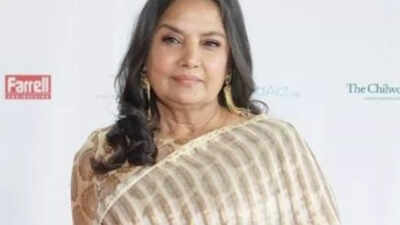- News
- entertainment
- hindi
- bollywood
- Shabana Azmi recounts the moment Guru Dutt fell in love with Kaifi Azmi's 'Waqt Ne Kiya Kya Haseen Sitam' for 'Kagaz Ke Phool': 'He did not know Urdu, but..'
Trending
This story is from November 30, 2023
Shabana Azmi recounts the moment Guru Dutt fell in love with Kaifi Azmi's 'Waqt Ne Kiya Kya Haseen Sitam' for 'Kagaz Ke Phool': 'He did not know Urdu, but..'
Shabana Azmi reminisces about the golden era of Hindi cinema in an interview, recalling Guru Dutt's reserved demeanor and her father Kaifi Azmi's unique music creation process. Contrary to conventional methods, Kaifi Azmi believed in crafting the tune before lyrics, metaphorically likening it to finding a suitable 'corpse' for a prepared 'grave.' Shabana also shares an anecdote about the iconic song 'Waqt Ne Kiya Kya Haseen Sitam,' highlighting Guru Dutt's passion for music despite limited Urdu knowledge.

Veteran actress Shabana Azmi recently shared insights about the golden era of Hindi cinema in an interview. Shabana, who grew up amidst the cinematic brilliance of her father, the renowned lyricist Kaifi Azmi, discussed the making of the iconic song ‘Waqt Ne Kiya Kya Haseen Sitam’ from Guru Dutt's film ‘Kagaz Ke Phool.’
Describing Guru Dutt as a reserved person off camera, Shabana revealed that he was remarkably shy and spoke very little. Despite his introverted nature, she found him exceptionally attractive. In an interview with Filmcompanion she became nostalgic about this.
Despite his introverted nature, she found him exceptionally attractive. In an interview with Filmcompanion she became nostalgic about this.
Discussing the music composition process of that era, Shabana highlighted her father's unique perspective. Contrary to the common assumption that lyrics were written first and then set to music, Kaifi Azmi believed that, in reality, the tune was crafted before the lyrics. He metaphorically compared it to digging a grave and then finding a suitable 'corpse' (lyrics) to fit into it. This unconventional approach added to the creative dynamism of the songs.
Shabana also shared an intriguing anecdote about the creation of ‘Waqt Ne Kiya Kya Haseen Sitam’ Kaifi Azmi and S.D. Burman had initially composed only the mukhda (opening lines) of the song. However, Guru Dutt, enamored by the composition, expressed his desire to include it in Kagaz Ke Phool, even though there was no existing situation in the film for the song. Undeterred, Guru Dutt insisted on creating a situation for the song, leading to the iconic status of ‘Waqt Ne Kiya Kya Haseen Sitam.’
Highlighting Guru Dutt's profound appreciation for music despite not being well-versed in Urdu, Shabana emphasized his ‘keen ear for music.’ She also noted the magical collaboration between individuals like SD Burman, who wasn't known for his Urdu proficiency, and Guru Dutt, resulting in timeless creations from that era. The story sheds light on the unconventional and collaborative nature of music production during the golden age of Hindi cinema, where creativity and innovation took precedence over traditional methods.
Describing Guru Dutt as a reserved person off camera, Shabana revealed that he was remarkably shy and spoke very little.

Discussing the music composition process of that era, Shabana highlighted her father's unique perspective. Contrary to the common assumption that lyrics were written first and then set to music, Kaifi Azmi believed that, in reality, the tune was crafted before the lyrics. He metaphorically compared it to digging a grave and then finding a suitable 'corpse' (lyrics) to fit into it. This unconventional approach added to the creative dynamism of the songs.
Waqt Ne Kiya Kya Haseen Sitam with lyrics | Geeta Dutt | Kaagaz Ke Phool
Highlighting Guru Dutt's profound appreciation for music despite not being well-versed in Urdu, Shabana emphasized his ‘keen ear for music.’ She also noted the magical collaboration between individuals like SD Burman, who wasn't known for his Urdu proficiency, and Guru Dutt, resulting in timeless creations from that era. The story sheds light on the unconventional and collaborative nature of music production during the golden age of Hindi cinema, where creativity and innovation took precedence over traditional methods.
End of Article
FOLLOW US ON SOCIAL MEDIA







